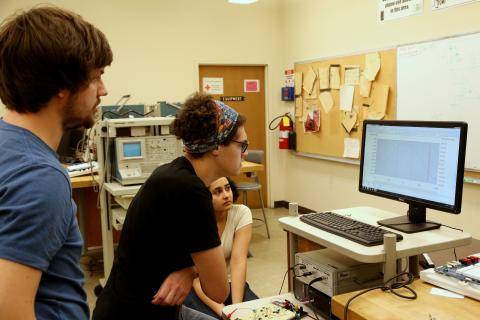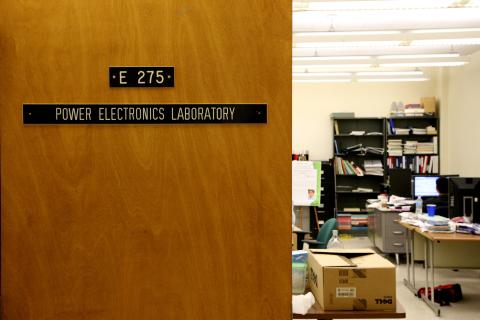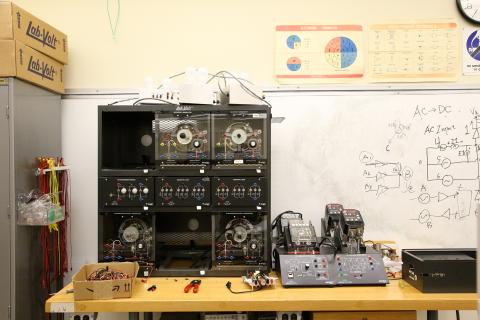In the Blake R. Van Leer building, electrical and computer engineering students toil away, tasked with seemingly unsolvable problems in instructional labs. These labs make up a core element of the curriculum at the School of Electrical and Computer Engineering (ECE), the largest producer of such graduates in the country. Without it, the lecture-based classes on concepts fundamental to the degree – such as signal processing, circuit analysis, and hardware and software system programming – would be nearly impossible to grasp in practical terms.
Or, as one graduate teaching assistant put it: “We’re seeing all these equations and wondering, ‘Where’s the benefit in that?’”Jamell Morell works in an electrical and electronic circuits laboratory as a graduate teaching assistant. He says such labs “bridge the theoretical to the experimental” in a way that gives his students a deeper comprehension of the lessons learned in a classroom.
But if electrical and computer engineering students truly are the “tinkerers, creators, and magic makers,” then the five men who help keep the school’s 22 labs running are the magicians behind the curtain.
Tom Brewer oversees ECE labs’ management or, as he affectionately explains, “if something goes wrong they’ll blame me.” But his devotion to the school is clear — if not through the creativity and humor he applies to his teaching, then through the sheer longevity of his tenure, nearly half a century long.
Brewer, who can be found listening to the Russian philharmonic orchestra in his office when not teaching, says the value of learning that takes place in ECE labs can ultimately be quantifiable come time for students’ graduation.
“The primary focus for most ECE students is getting a job and getting a career going,” he says. “I’ve been told that many of them, when they go out for interviews, are asked practical questions that they learned in the lab.”
Lab focuses range from digital design, where students combine analog and digital hardware programming skills, to senior design projects, in which students are asked to create something and make it work. That could mean a rocket-launching system, a robotic bartender, a sensor that controls the volume on a television by reading brain waves, and everything else in between.
Brewer is joined by four other staff members who help keep these labs operational. Kevin Pham and James Steinberg work in senior design labs, Allen Robinson in audio engineering, and Kevin Johnson in digital design. For them, running their labs means purchasing equipment, helping with budget proposals, and, importantly, solving engineering problems that students and teaching assistants come across.
Problem-solving is arguably the most crucial component of the learning that takes place in ECE’s instructional labs. Johnson calls this “the debugging process” in his digital design lab.
Johnson explains that in lecture classes, there generally isn’t much of an iterative problem-solving process: A student is given a problem; they answer it, are told whether or not they were correct; and are then told the answer.
“So there isn’t the sort of ‘what did I do wrong, where did that occur, and how do I fix it?’ process that really is a huge part of engineering,” Johnson says.
When students first start a lab class, they often don’t know where to begin when the inevitable first problem arises.
“There are so many things that can go wrong. When you’re building this complicated system… and you’re writing software for it, and it’s interfacing with peripherals like switches and push-buttons, trying to figure out where something is going wrong can be a pretty daunting task,” says Johnson, who spends a fair amount of time repairing robots that break during final projects.
This kind of practical experience teaches students to solve problems by breaking them down into smaller parts of the whole. With the support of teaching assistants and staff members like Johnson, students learn to eliminate areas that are properly working and how best to find where exactly the breakdown lies.
“You actually use the equipment, and through measuring these circuits that we learn about in class and by looking at them on the oscilloscope [an instrument with which one can observe varying signal voltages], we’re able to see, ‘OK, this is a high-pass filter… this is a square wave,’” says Morell.
Students’ exposure to high-powered lab equipment is set to increase dramatically. A new maker space, made possible by a Texas Instruments gift, will provide them with access to cutting-edge technologies and an exciting place to interact with equipment outside of class.
Sai Sathiesh Rajan, a third-year ECE student, says the maker space will be “a way to get practical skills, like soldering, and exposure to components, like oscilloscopes, before their third year [of ECE classes].” Such skills are highly sought after, and useful earlier on in ECE studies than the current curriculum generally offers.
The senior design course is one reason that greater hands-on experience is valuable. Between the two, Steinberg and Pham oversee the senior design projects of roughly 250 students.
Steinberg says their responsibilities run the gamut: helping undergraduates, professors, graduate and doctorate students to build circuits and inductors, populate printed circuit boards, and with research projects and proposals.
“It’s an interesting job — fun! — but it keeps you busy,” Steinberg says. “You have no downtime, you can be sure of that.”
But for all their responsibilities, the staff expressed an admiration for working with the students and watching their projects evolve.
When asked about his favorite part of the job, James Steinberg laughed. “I learn more from the students than I did in school,” he says. “I enjoy seeing them succeed; I like to see them grow.”
Steinberg and his colleagues’ support is integral to ECE students’ growth.
“These students are just very, very creative,” says Bonnie Ferri, associate chair for undergraduate affairs in the school.
“What we want to do is take that imagination and their ideas, and give them the skills, and the equipment, and the space for them to fly with that.”
Additional Images


